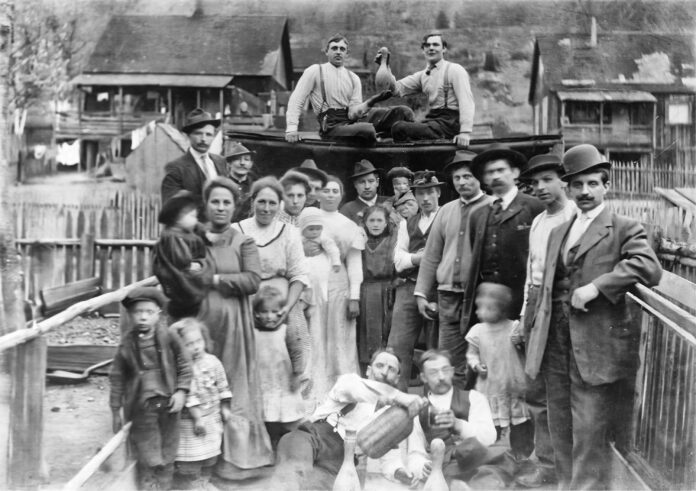The past two weeks’ columns have detailed the coal mine established by Eugene Lawson in 1895 near Black Diamond. The first opening became known as Old Lawson. About 200 feet higher up the hill, a new settlement called New Lawson was constructed. Housing for workers was built near both portals as Old Lawson was dominated by Austrians and Germans while New Lawson supported a large Finnish population. The Pacific Coast Coal Company purchased the town of Lawson and its mines in May 1899. Then in 1904, Pacific Coast acquired the Black Diamond Coal Mining Company’s two much larger operations, Mine 11 and Mine 14, as Eugene Lawson helped broker the deal.
Lawson consisted of upper and lower settlements. Old Lawson was located at approximately 26000 Old Lawson Road, while New Lawson was south of the terminus of Botts Drive. The connected mines were completely destroyed by a catastrophic explosion on Nov. 6, 1910, that claimed the lives of 16 men.
This photo was taken in Old Lawson several months after the tragedy. The folks who lived there had constructed an outdoor bowling alley where many residents posed for a picture. The photo was donated to the Black Diamond History Museum together with a letter from John “Cut” Kravagna whose family lived in Old Lawson. The Kravagna family emigrated from Austria in about 1908. The father, Anton found work in the coal mines, and his wife, Antonia eventually bore and raised six children.
Below is a partial transcript, with corrections of the caption that John “Cut” Kravagna, then living in El Segundo, California provided to Cart Steiert, President of the Museum. In Black Diamond during the early 1900s, many of the boys and men had nicknames. John gained “Cut” during his younger days as a boxer. His oldest brother, Hubert Kravagna labored as a coal miner for 49 years, completing his career at Palmer Coking Coal Co.’s Roger No. 3 mine in 1966. Nicknames, proper names, and clarifying edits are in (parentheses).
“I received your request through the newsletter for a photo of Old Lawson Bowling Alley. The photo was taken in the early part of 1911. If you notice on the left side, my mother (Antonia Kravagna) is holding my brother “Jazz” (Charles Casper Kravagna), and was pregnant with me. In front of her is my sister, Mary, and brother, “Chic” (Anton T. Kravagna). My dad (Anton Kravagna) is the one holding the bowling ball. On his right is Jack Shaller, and next to him is Mr. (Casper) Erath holding young Casper (“Gosh”). On the left in the rear with the hat and mustache is Mr. Thomas Wieltschnig. Two guys on top holding the bowling pin were both killed in the mines. I don’t know their name.
In front, pouring wine, I believe is Teenie’s (Val Sternig) dad, Philip Sternig. Holding the glass is the owner of the bowling alley, Andrew Premosich (Squirrel Tail). Old Lawson had three rows of houses. This picture was taken on the lower row – the middle and upper rows are visible in the picture. The bowling alley was made of clay. You can see the trough where the ball was rolled back (on the right where a man in a hat is resting his elbow). The ten pins were under the shack (where two miners hold a bowling pin).”
This photo comes courtesy of the Black Diamond History Museum. Photo enhancements were undertaken by Doug “Boomer” Burnham, a Tahoma High School photography instructor.








